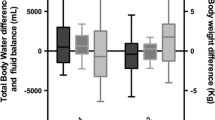Abstract
Body composition was measuredwith bioelectric impedance analysis (BIA) in 30 patients with protein malnutrition following biliopancreatic diversion. Determinations were carried out prior to, during, and at the completion of intravenous nutritional support when the nutritional parameters had completely reverted to normal. Before treatment, body weight (BW), lean body mass (LBM), and body fat (BF) values were similar to those of controls, whereas the total body sodium/total body potassium (TBNa/TBK) and extracellular mass/body cell mass (ECM/BCM) ratios were considerably higher. During the support, no changes in BW, LBM, and BF were demonstrated, although a sharp decrease of TBNa/TBK and ECM/BCM was observed, thus demostrating improved LBM composition. At the end of parenteral feeding, the BW, LBM, and BF values were similar to those observed before the support, while a further decrease in TBNa/TBK and ECM/BCM demonstrated a recovery towards normal of body composition. The full correspondence between clinical and BIA findings therefore suggests that this method may be valuable for monitoring body composition changes during nutritional support.
Similar content being viewed by others
References
Khaled AM, McCutcheon MJ, Reddy S, Pearman PL, Hunter GR, Weinser RL (1988) Electrical impedance in assessing human body composition: The BIA method. Am J Clin Nutr 47:789–792
Kushner RF, Schoeller DA (1986) Estimation of total body water by bioelectrical impedance analysis. Am J Clin Nutr 44:416–424
Lukaski HC, Johnson PE, Bolonchuck WW, Lykken GI (1985) Assessment of fat-free mass using bioelectrical impedance measurements of the human body. Am J Clin Nutr 41:810–817
Segal KR, Van Loan M, Fitzgerald PI, Hodgon JA, Van Itallie TB (1988) Lean body mass estimation by bioelectrical impedance analysis: A four-site cross validation study. Am J Clin Nutr 47:7–14
McDougall D, Shizgal HM (1986) Body composition measurements from whole body resistance and reactance. Surg Forum 37:42–45
Jodoin RR, Trott SG, Shizgal HM (1988) Determination of body composition from whole body electrical impedance. Surg Forum 39:50–52
Scopinaro N, Gianetta E, Friedman D, Traverso E, Adami GF, Vitale B, Marinari M, Cuneo S, Ballari F, Colombini M, Bachi V (1992) Biliopancreatic diversion for obesity. Problems in Gen Surg 9:362–379
Adami GF, Summa M, Castagnola M, Marrante G, Camerini G, Scopinaro N (1988) Malnutrition, nutritional support, and total body composition. Ital J Surg Sci 18:63–67
Author information
Authors and Affiliations
Rights and permissions
About this article
Cite this article
Adami, G.F., Marinari, G., Gandolfo, P. et al. The use of bioelectrical impedance analysis for monitoring body composition changes during nutritional support. Surg Today 23, 867–870 (1993). https://doi.org/10.1007/BF00311363
Received:
Accepted:
Issue Date:
DOI: https://doi.org/10.1007/BF00311363




